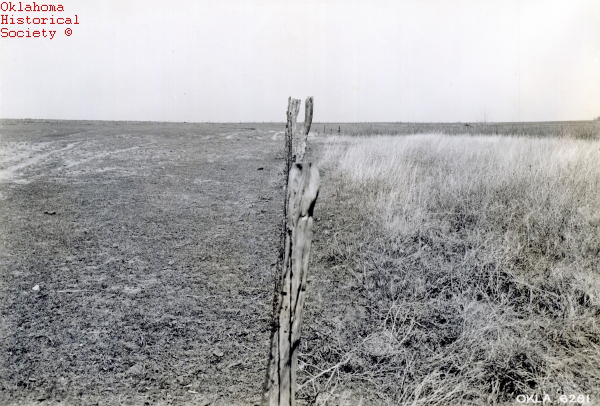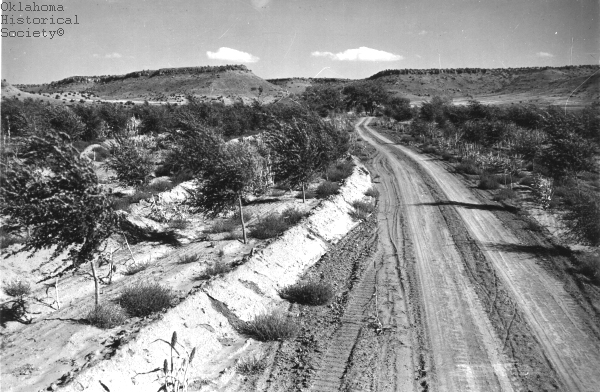
The Encyclopedia of Oklahoma History and Culture
SOIL AND WATER CONSERVATION.
When the Federal Homestead Act passed Congress in 1862, and, later, when American Indians, early whites (legal and illegal), and African Americans (legal and illegal) occupied Indian Territory, Oklahoma had fertile and productive soils that supported lush native grasslands and forests. Land was abundant and labor scarce. Many farmers plowed their land up and down hills, left the soils bare after harvest, and did not replenish the depleted nutrients. Much of the soil soon washed away as gullies developed. Consisting of small terraces that easily broke after rain, early conservation efforts were piecemeal, uncoordinated, and localized.
Over 15 percent of the land had been taken out of production by the 1930s when the first soil surveys revealed that more than six million acres of land in Oklahoma had erosion problems. From Washington, D.C., at the U.S. Department of Agriculture Bureau of Soils, Hugh Hammond Bennett, soil scientist and father of soil conservation, challenged agricultural practices that contributed to soil degradation. In 1929, when erosion was shown to be a national problem, Congress appropriated $160,000 to initiate a nationwide effort to arrest it. Ten regional soil conservation experiment stations were established to measure soil loss, conduct surveys to determine the extent of erosion damage, and develop control methods. The Red Plains Research Station in Guthrie was the first experiment and demonstration station in Oklahoma. N. E. Winters, the first director, established other demonstrations on Stillwater Creek (Stillwater), Pecan Creek (Muskogee), Elk Creek (Elk City), Camp Creek (Seiling), Tulip and Henry creeks (Ardmore), Little Washita Creek (Chickasha), Taloga Creek (Stigler), Coon Creek (Duncan), Guymon Creek (Guymon), and Pryor Creek (Pryor). Successful lessons were transferred to privately owned land in the state and the nation.
The National Industrial Recovery Act of 1933 authorized $5 million for erosion control and employment programs. On September 19, 1933, Bennett became the director of the new Soil Erosion Service (SES) in the Department of the Interior. On March 25, 1935, the SES was transferred to the Department of Agriculture, and through the Soil Conservation Act of April 27, 1935 (Public Law 75-46), reorganized into the Soil Conservation Service (SCS, now called the Natural Resource Conservation Service, or NRCS). The mission of the SCS was to control and prevent soil erosion, flooding, and other threats to natural resources. Bennett became the first chief.
Abused land, a prolonged drought, overgrazing, and little use of cultural, structural, and vegetative conservation practices produced barren rangelands that were highly susceptible to wind and water erosion in the 1930s. Dust storms captured national attention. The term "Dust Bowl" was coined to describe the conditions of the land in Oklahoma, Kansas, Colorado, New Mexico, and Texas. Many farmers migrated elsewhere. The rest of the nation took the dust storms seriously on May 11, 1934, and April 14, 1935, when they reached the eastern seaboard.
In March 1933 Congressional legislation established the Civilian Conservation Corps (CCC) to provide employment for young men and veterans of World War I and help people cope with the Great Depression. Dr. N. E. Winters directed over 1,100 workers in thirty-seven Oklahoma communities, including Ardmore, Beaver, Checotah, Gasker, Idabel, Mountain View, Nowata, Sayre, and Wilburton. CCC workers freely developed conservation practices on farms.
By means of the Standard State Soil Conservation Districts Act of February 1937, states were strongly encouraged to legislate mandatory soil conservation in order to qualify for SCS benefits. Oklahoma passed such a law in April of that year. Thus, Soil Conservation Districts were created, and SCS specialists worked through the districts.
In 1936 the Soil Conservation and Domestic Allotment Act established the Agricultural Conservation Program (ACP). The Agricultural Stabilization and Conservation Service (ASCS) and the SCS administered the first cost-sharing "green" program designed to encourage farmers to restore and improve soil fertility, minimize wind and water erosion, and conserve resources and wildlife.
Floods, another means of soil loss, led to the destruction of crops, productive land, fences, livestock, homes, and human lives. Interest in flood control began in spring 1934 when the Washita River flooded, killing seventeen people. On June 22, 1936, Congress passed the Omnibus Flood Control Act (PL 74-738), to protect watersheds, prevent floods, and complement the downstream flood control program. Farmers signed five-year agreements to install grassed outlets and grassed waterways, to vegetate gully areas, to build grade stabilization structures and contour terraces, to practice pasture management, strip-cropping under longer rotation, and reforestation, to grow hay crops into crop rotations, and to fence off woodland from grazing.
The construction of small dam structures on eleven watersheds around the nation started with the Flood Control Act of 1944 (PL 78-534). The first flood control dam to be completed in the nation under that federal legislation was on Cloud Creek, a tributary of the Washita. With more than five million acres of agricultural land, the Washita River Watershed is the world's largest contiguous land area treated with conservation practices. By 1977 the Washita and its sixty-four subwatersheds had over 1,200 dams. Oklahoma was the first state to develop a watershed flood control dam, have an entire watershed project completed (the Sandstone Creek Watershed), develop a multipurpose flood control structure (Lake Humphrey), complete 1,500 upstream flood control dams, and complete 1,776 watershed structures.
The Watershed Protection and Flood Prevention Act of 1954 (PL 83-566), or the Small Watershed Program, was passed to protect rural communities and small towns, provide recreation and water supply for municipalities and rural districts, and provide irrigation and drainage in upstream tributary watersheds of less than 250,000 acres. In 1963 the 120,980-acre Bear, Fall, and Coon creeks project in Lincoln, Logan, and Oklahoma counties was completed. By 1998, 1,604 projects had been authorized around the nation under the 1954 act. Although the government required matching funds, it was possible to have the SCS pay 100 percent of the costs. Local people initiated the projects, SCS provided the funds, and the districts maintained the structures. Following the 1954 floods the state charged a one-cent-per-gallon gasoline tax to pay for the repairs to bridges.
At the end of the twentieth century Oklahoma had 2,094 small watershed structures, and more than $172 million had been spent on watershed development. During the fiftieth anniversary celebration for Cloud Creek, calls were made to reinvest in the watershed program. Present were U.S. Rep. Frank Lucas, Gov. Frank Keating, and NRCS chief Pearlie Reed. Later, in 2000 Lucas authored the Small Watershed Rehabilitation Amendments Act, which authorized $90 million over five years in cost-share arrangements to rehabilitate watershed dams.
On August 7, 1956, Congress established the Great Plains Conservation Program (GPCP) to develop conservation methods. Later adopted nationwide, these practices included strip-cropping, windbreaks, waterways, terraces, diversions, erosion control dams, grade stabilization structures, and water-spreading systems. Forty-three Oklahoma counties west of U.S. Highway 81 were in the GPCP. Farmers signed contracts to participate for up to ten years. Oklahoma had the largest number of active contracts among the GPCP states. More than $29 million was spent, more than 184,000 acres of grass planted, 3,700 wells drilled, 3,200 ponds built, 7,000 acres of waterways established, 52 million feet of terraces built, 1,475 erosion control dams built, and 15,000 acres leveled for irrigation.
The GPCP stabilized American agriculture. Grain exports doubled when the grain price quadrupled between 1970 and 1974. Farmers removed wide windbreaks, established center-pivot irrigation systems and narrower windbreaks, and put large tracts of land into production. However, wind erosion increased, and the government was advised to stop payments to those who farmed fragile lands. By the 1980s and 1990s conservation efforts concentrated on retiring highly erodible lands (HEL), maintaining wetlands, conservation tillage, windbreaks, pasture and range management, wildlife enhancement, water quality, and small dams (creating more than 205,000 ponds). The NRCS (formerly the SCS), Farm Service Agency, Cooperative Extension Service, and conservation districts promoted the increased use of conservation tillage, windbreaks, rotational grazing, and prescribed burning. The Food Security Act of 1985 linked soil conservation to eligibility for USDA programs. To remain eligible, farmers signed contracts to implement conservation plans by 1995. HEL land was retired through the Conservation Reserve Program (CRP). Farmers received annual rent payments for the land they retired from production for ten years. Environmentalists wanted the program continued, but agribusiness wanted land reverted to production.
The 1990 Farm Bill put more emphasis on water quality through the Wetland Reserve Program and the Water Quality Incentives Program. The 1996 Farm Bill combined the Great Plains Conservation Program, the Agricultural Conservation Program, the Water Quality Incentives Program, and the Colorado River Basin Salinity Program into the Environmental Quality Incentives Program (EQIP). The EQIP program addressed conservation issues in areas with significant natural resource problems. Top priority was given to areas with state or local government support through financial, technical, or educational assistance and in which agricultural improvements would help meet water quality objectives. Landowners and tenants were issued five- to ten-year contracts (payments) and cost-sharing incentives (up to 75 percent of the cost) to establish conservation practices such as manure management, pest management, and erosion control systems. Started in 1997, by March 2000 the program had 2,470 EQIP contracts with $12,108,106 obligated funds, and 25,411 conservation practices on 671,393 acres. Thus, at the dawn of the twenty-first century soil and water conservation remained a high priority in Oklahoma and elsewhere.
See Also
CLIMATE, CONSERVATION DISTRICTS, DROUGHT, DUST BOWL, ENVIRONMENT AND CULTURAL ECOLOGY, RIVERS AND STREAMS, WATER COMPACTS, WATER QUALITY ACTS







